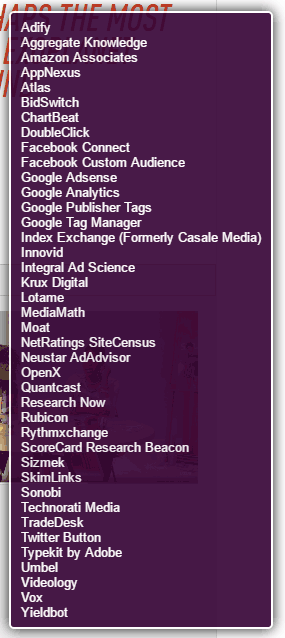
Breaking News 2: When good ads go bad
I can think of nothing that has done more harm to the internet than ad tech. It interferes with everything we try to do on the web. It has cheapened and debased advertising and spawned criminal empires.
—Bob Hoffman (The Ad Contrarian), “How Much of Your Audience is Fake?” Bloomberg
My 93-year-old mom called the other day, almost in tears. After clicking a legitimate-looking link at RealClearPolitics, her browser had been taken over by popups that re-popped every time she closed them, even after quitting and relaunching the browser. My mother was another victim of modern advertising.
Old hotness, new and busted
Once upon a time, an advertiser contracted a media agency to place specific advertisements in specific publications. Publishers provided “tear sheets” proving the ads had run. The agency got 15 percent of the ad’s cost; the publishers pocketed the rest.
This type of advertising built the brands of nearly every major product. So, obviously, the entire industry needed radical disruption.
Swarms of startups began innovating advertising technologies. Among the things they’d do (all real company slogans; YCMTSU):
- “Build, run, measure and optimize retargeting-driven display campaigns.”
- “Deliver cohesive messaging to qualified consumers at scale.”
- “Analyze first-party premium publisher site-level data to pinpoint active consumer intent.”
Mainly what they did, though, was radically raise their rates.
The old 15 percent cut for media agencies has creeped up to 55 percent in 2014. In 2015, the creeps took 60 percent.
The ad tech tax
“Ad tech” is the new automated way we buy, sell, deliver and display online advertising. The cost for this convoluted complexity is ‘“the ad tech tax.”
A user clicks on a website and suddenly her internet address and browsing history are packaged and whisked off to an auction site, where software, on behalf of advertisers, scrutinizes her profile (or an anonymized version of it) and determines whether to bid to place an ad next to that article. Ford Motor could pay to put its ads on websites for car buffs, or, with the help of cookies, track car buffs wherever they may be online. Ford might want to target males age 25-40 for pickup-truck ads, or, better yet, anybody in that age group who’s even read about pickups in the past six months.
—“The Fake Traffic Schemes That Are Rotting the Internet,” Bloomberg
Good luck following this Interactive Advertising Bureau chart of a typical ad buy:

Making a bad impression
Agencies bill advertisers by the impression, a semi-mythical event, said to occur (by the Media Rating Council) when half an advert’s pixels are “in view” for one continuous second — two seconds for video ads.
But bots (e.g., search engines) “view” half these ads, not humans. Another quarter are fraud, in its many forms. And 15 percent are broken ads that never display at all.
So, 85 percent of paid-for impressions are either bogus, broken or bot-hits. Reid Tatoris, co-founder of Are You a Human?, breaks down the remainder:
We start with the notion that only 15 percent of impressions ever have the possibility to be seen by a real person. Then, factor in that 54 percent of ads are not viewable (and we already discussed how flawed that metric is), and you’re left with only 8 percent of impressions that have the opportunity to be seen by a real person. Let me clarify: that does not mean that 8 percent of impressions are seen. That means only 8 percent have the chance to be seen. That’s an unbelievable amount of waste in an industry where metrics are a major selling point.
—“The Definition Of An Ad Impression,” MediaPost
Ad tech fails in targeting specific people. It fails even in finding any person or, worse, finds the wrong people.
The online advertising system has proved easy to scam. A convicted terrorist duped Google into buying ads on his site for Citigroup, IBM and Microsoft. The Financial Times headline read, “Jihadi website with beheadings profited from Google ad platform.” This FT Business video explains:
We know what you did last summer
My full IP address is being passed around like chips at a Super Bowl party: a total of 291 times.
—Rob Leathern, CEO of Optimal.com, “The Mobile Video Ad Lie”

Ad tech is ravenous for data — our data. We sacrifice our patience (waiting for webpages), and our privacy and our pocketbooks (cellphone plans) so ad tech can gorge on our private parts.
For example, the image at right is from TheVerge.com. It’s a Ghostery list of all the site’s scripts — mostly for ads, social sites and user tracking. This page weights 10.3 MB. But by ad-blocking the scripts, it’s only 938 KB, 11 times smaller so it loads that much faster.
Each ad gets its own iframe, so load is asynchronous and, if one fails, it doesn’t kill the entire site. Unfortunately, that also means each one fires its own trackers, even if those trackers are identical across ads. It’s terribly inefficient.
We’ve tried to find or figure out a way to streamline them, but haven’t been able to. They’re built into the foundations of all the major networks, ad and social, ostensibly to provide more “relevant” content.—“Content blockers, bad ads, and what we’re doing about it,” iMore
It gets worse: Ad-tech and social-site tracking combined can now individually identify who you are, who your friends are, and what you and they do online. Read and weep: “On the Leakage of Personally Identifiable Information Via Online Social Networks” by AT&T Labs and Worcester Polytechnic Institute researchers.
Stuffing all these scripts down our browser’s throats chokes online news. My Reynolds Journalism Institute research data on websites showed 56 percent of their page-weight and 35 percent of their file-requests were scripts. The New York Times examined 50 news sites and “found more than half of all data came from ads and other content filtered by ad blockers.”
Ad tracking ticks people off. Ad stalking creeps people out:How annoying are each of the following mobile ads?
- Ads that pop over my entire screen: 73 percent
- Ads that seem to “follow” me from my computer to my phone: 65 percent
—“Why People Block Ads,” HubSpot surveyWhat respondents dislike about websites:
- Ads that interfere with content: 55 percent
- Ads that redirect me to sites I don’t want to see: 52 percent
- Slow page loads (poor response time): 50 percent
—“What erodes trust in digital brands?,” Neustar survey
Two-thirds of Neustar’s respondents checked: “I do not trust websites that take too long to load” in a list of “Perceptions about trustworthy news sites.” (Grammarians, rejoice: The No. 1 choice was “I do not trust websites that contain errors or mistakes” at 91 percent.)
Ad targeting: hit or miss?
All these precision-targeted, big-data-driven ads have sales soaring, right? Wrong.
Online advertising efficiency is in a nosedive. This Kalkis Research chart shows a plunging ratio of revenue dollars to dollars spent on digital marketing:

When eBay tested ad tech by turning off search ads in half the U.S. cities, “sales stayed the same even as eBay’s advertising expenditure dropped.” When Procter & Gamble targeted Febreze (an air freshener) ads at pet owners and large-family households, sales remained flat. When, instead, they sent the ads to anyone over 18, sales rose.
The only thing online advertising sells well is ad blockers, which Doc Searls calls “the biggest boycott in history.”
Online advertising efficiency has been decreasing for years, and companies have to spend more ad dollars for the same result. The process of ad placement has become ever more automated, obscure and complex, while intermediaries have multiplied, each taking a cut from the client’s initial ad budget. Controls and regulations are nonexistent, and a big chunk of ad spending is being stolen, plain and simple.
Websites have been invaded by click ads, display ads, and forced video ad views. Naturally, internet users have grown sick and tired of this ad pollution, and have started installing ad-blocking software. What makes this trend worse is that users who install ad blockers first, tend to be the more sophisticated and the more affluent ones.—“End Of The Online Advertising Bubble,” Kalkis Research

This Bloomberg video follows the fake monetizing:
The wrong advertising
Ad tech companies aren’t profitable, yet they grow like weeds. In 2011 there were 150; now, in 2016, there are 3,500.
I’ve yet to mention near-zero click-through rates and ad agency kickbacks, or high-frequency price pumping, non-human trafficking and malvertising ransomware. But I think you’ve heard enough. (Consult The Ad Contrarian for the complete hows and whys of ad-tech failures.)
We web publishers could choose to end this madness. We could prioritize speed and security on our sites and support the privacy projects. We could collaborate on open-source, performant tracking and ad-delivery processes, with opt-ins and data storage expiration dates (read Maciej Cegłowski’s “Haunted by Data”). Our readers would love us for it, and advertisers can’t resist loving readers.
For now, I’ll leave you with this 1983 thought from David Ogilvy, the O.G. of Mad Men:
The wrong advertising can actually reduce the sales of a product. I am told that George Hay Brown, at one time head of marketing research at Ford, inserted advertisements in every other copy of the Reader’s Digest. At the end of the year, the people who had not been exposed to the advertising had bought more Fords than those who had.
In another survey it was found that consumption of a certain brand of beer was lower among people who remembered its advertising than those who did not. The brewer had spent millions of dollars on advertising which un-sold his beer.
I sometimes wonder if there is a tacit conspiracy among clients, media and agencies to avoid putting advertising to such acid tests. Everyone involved has a vested interest in prolonging the myth that all advertising increases sales to some degree. It doesn’t.—David Ogilvy, Ogilvy on Advertising
Next in the Breaking News series, we scrutinize a few new media myths.
Notes: You can check and manage your own Google ads personalization and Facebook ad preferences. Thanks to Jon Nehring for the Ghostery screenshot.

Comments